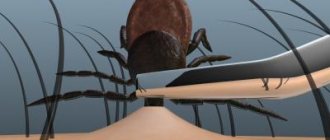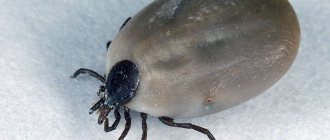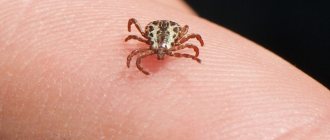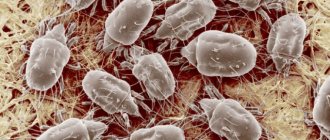Everyone has a general idea of how dangerous ticks are, but rarely does anyone have relatively complete information. We will try to tell you everything about ticks that a person needs to know to ensure safety. They are capable of transmitting not only encephalitis, but also many other diseases during the tick season. There is not only the well-known taiga tick that attacks in May during forest walks. The danger of parasites is not limited to bites in the forest, which cause itching and irritation. The species of ticks are numerous and their lifestyles are varied. Often people don’t even know that they have to share a roof with entire broods of these spiders, and it certainly doesn’t occur to them how long a tick lives on a person’s body or in a residential building.
General description of ticks
Ticks belong to the subclass of arthropods of the arachnid class. The mite order has more than 54,000 species. By size they are classified as small, small and microscopic spiders. Their size allowed them to settle into the top layer of soil, rich in decaying organic matter, which led to such a diversity of species.
Appearance
Ixodid tick photo
The structure of mites is not diverse. Animal and domestic ticks have undergone some internal changes compared to their wild counterparts. These arachnids have both a non-segmented body and an oval or spherical body divided into an abdomen and head. It is covered with hard chitinous plates or shell. Ticks have 6 pairs of limbs, the first 2 form a kind of proboscis, the remaining 4 are used for movement. The first pair has a claw-like shape; under a microscope, the mite resembles a kind of crab (photo is provided).
All ticks are divided into 2 sexes; development occurs with metamorphosis. Ticks reproduce at different rhythms depending on living conditions. The first stage is the laying of eggs, from which the larvae emerge. During its development, the tick larva molts several times. After the first molt, she enters the nymph stage, after the last she is considered mature (imago). Different types of ticks at the larval stage go through several periods of transformation, marking the next stage of development. Ticks reproduce where they live. Ticks feed on liquid or semi-liquid food.
Nutrition and threat to humans
The vast majority of arachnids are free-living in the natural environment; only a few species of ticks live off humans. Parasites feed on the blood or biological material of people and animals; so-called saprophages consume plant or animal remains. Some types of mites prefer living plants.
House ticks have adapted to living near humans or on their bodies. Most ticks live in natural conditions, including the most dangerous species - the taiga tick (also known as the ixodid tick). It is he who is the carrier of many dangerous diseases. Ticks choose damp places, ravines, and prefer tall, dense grass and shady places. Having a good sense of smell, they set up ambushes along forest paths. Information about where ticks live, what types of ticks are found specifically in your area, which areas are treated and safe, and when the highest tick activity is achieved can be obtained from the sanitary and epidemiological station.
Bottom view of a tick
Ticks are most active in May and June. It is believed that in September the taiga tick and other types of parasites dangerous to humans and animals no longer attack and do not pose a danger. Are ticks dangerous in the fall? In fact, activity directly depends on weather conditions. Warm summers and autumns significantly prolong the period of tick activity, which may end in October, although bites are especially dangerous in spring and early summer. It is safe to say that ticks do not attack or be active in winter in any case, but the full range of “hunting” is recorded from April to November.
At what temperature ticks die depends on the living conditions. When ticks are outside the donor’s body, they can die at a temperature of +7ºС…+14ºС within 2-3 weeks, at +60°С - within an hour. In cold weather, the parasites go into suspended animation and lay eggs in the spring, thereby completing their life cycle. Where ticks overwinter also depends on the conditions and the specific species. In the natural environment, they burrow into the grass and leaves of the ground layer. This allows you to overwinter at the lowest temperatures. Life expectancy, depending on the species and taking into account periods in suspended animation, can reach 10 years.
How dangerous are ticks to humans? The likelihood of transmitting serious diseases acquired from wild animals through saliva is too high. The activity of ticks in the spring-summer period leads to the fact that in Russia 2000-3000 people become infected with encephalitis per year. A tick bite can also cause:
- epilepsy and hyperkinesis;
- Lyme disease (borreliosis);
- nephritis;
- arthritis;
- indigestion;
- blood pressure surges and arrhythmia;
- pneumonia or pulmonary hemorrhage;
- complete loss of legal capacity and ability to move and care for oneself (in the worst cases).
How dangerous is tick-borne encephalitis for humans?
Encephalitis is a viral infection.
Its distribution pattern looks like this: animal – tick – animal. In other words, jitters acquire the virus when they attack infected animals. They themselves do not get sick, but they transmit the infection to those they bite. There is another way to spread the infection. It is enough to drink the milk of an infected animal to catch the virus. Treatment of tick-borne encephalitis is carried out in a hospital setting under the supervision of doctors. Lack of drug therapy leads to death. Therefore, timely reporting to a doctor about a itch bite can save a person’s life.
Spread of encephalitis ticks
In Russia, ticks are represented in all regions. There are especially many of them in the Urals, the Far East, the Volga region, and Siberia. Most often, minors become victims of itching. According to statistics, ¼ of those infected are children under 14 years of age.
Symptoms of tick-borne encephalitis
The danger of tick-borne encephalitis is that it does not manifest itself immediately. The incubation period lasts 1-2 weeks. It’s good if a person discovered the insect in time, extracted it and took it to the laboratory. There they will conduct tests and find out whether the tick is a carrier of encephalitis or not.
However, people do not always notice that they are becoming victims of itching. They mistake the first signs of encephalitis for other diseases and begin to treat them. The consequences may be irreversible. Therefore, it is important to know the symptoms of the disease.
Typical manifestations of infection are:
- A sharp increase in temperature. For 2-5 days the thermometer will show 38-40°C.
- Symptoms of body intoxication: headache, weakness, nausea, vomiting.
- Redness of the skin in the face and neck.
- Distracted attention, state of stupefaction.
There are often cases when the disease is asymptomatic. After a sharp deterioration, health returns to normal and the person feels healthy. However, the infection continues to affect the gray matter of the brain.
The dangers and consequences of tick-borne encephalitis vary from person to person. Some patients feel completely healthy after recovery. Others experience cognitive impairment or paralysis.
Other diseases carried by the parasite
These are the most dangerous and widespread diseases, but this is not all that the taiga tick is dangerous for. Its bite can cause:
- Tick-borne typhus, relapsing typhus, tick-borne typhus.
- Piroplasmosis.
- Hemorrhagic, Marseilles fever, spotted fever.
- Tularemia.
History of tick-borne encephalitis
The history of the appearance of tick-borne encephalitis leads us to the forests of the Far East, Siberia, and the Urals, because this is a natural focal disease, which suggests the existence of persistent foci of infection in certain natural areas that are supported by wild animals.
Actions to take if bitten by a tick
Not every tick is infected, but the possible danger should not be underestimated. With timely medical care, even an infected tick will not cause harm or it will be minimal. If it is not possible to promptly contact a medical facility, the tick must be removed on your own. When removing a parasite, it is important to not allow the parasite to rupture. In this case, the head will be under the skin, and it is in the head that all the toxic substances are concentrated. There are several basic methods for removing ticks.
Removal using tools
Devices for self-removal of ticks are available in the form of plates with a drop-shaped hole and spoons or hooks with a V-shaped slot. The embedded tick must be pryed as deep as possible under the head and carefully pulled out using twisting and rocking movements. All tools are small in size and can be used as key rings. Products available include Tick Twister and Trixie hooks, Ticked Off spoon, Pro-Tick and Tick Key plates.
Tick removal hook
The Tick Remover, which is similar in principle to a collet pencil, deserves attention. Among the domestic tools we can name tweezers for removing ticks Anti-Mite. Anti-Mite differs from ordinary tweezers in its triangular working part made of wire, which is convenient for capturing the parasite. The principle of operation is the same: the tick is grabbed as close to the head as possible, swings and turns outward.
In the absence of special tools, you can use ordinary medical tweezers, but in this case the risk of tick rupture increases. The original method is to extract the parasite using a regular disposable syringe. The cylindrical part of the syringe is cut off from the side where the needle is attached, the resulting hollow cylinder is pressed tightly to the bite site so that the tick is inside. After this, the piston is pulled out, and the spider jumps out under the influence of vacuum.
Removal without tools
The most well-known method is to remove the tick using a harsh thread or thin rope. The insect must be wrapped in a loop, loosened and carefully removed, continuing to swing from side to side. The method of removal using oil is considered dangerous; doctors are categorically against its use. The removal principle is based on the assumption that if you drop oil on an embedded parasite, it will begin to suffocate and crawl out of the wound on its own. This is not to say that this is impossible, but first the tick can regurgitate inside the person everything that it managed to suck out. It is possible that the spider will simply suffocate and die, remaining in the body. A very extreme method is to remove the tick with your fingers. The risk of crushing the parasite in such cases is extremely high. If the extraction is carried out by another person, then the infection can spread to him.
What to do after extraction
If extraction was unsuccessful and the head remained under the skin, it must be removed with a disinfected needle. After extraction, in any case, the wound is treated with iodine, alcohol (vodka) or another disinfectant solution. The extracted tick must be submitted to a laboratory for testing. If an insect is removed in a medical facility, such a study is required. For greater safety, the extracted tick is placed in a plastic bag or glass flask (vial) with soaked pieces of paper.
Preventive actions
In order to protect against ticks in places where they may live, it is necessary to wear tight clothing that covers all parts of the body. A headdress or scarf is required. Ticks live at a height of about 1 m above ground level; falling from above rarely occurs. The parasite can also attack from the ground, and does not immediately bite into it. He begins to climb up in search of a comfortable place. It can take several hours from the moment of contact with the body to the bite, so after returning home you need to carefully examine not only your body and your pet, but also your clothes. Particularly attractive areas for ticks are the armpits, groins and neck. A tick bite is painless.
The right clothes for the forest
Among the medical means for protection we can recommend:
- repellent (repellent): Gall-RET, Deta-WOKKO, Biban, Reftamid maximum, Off! Extreme, DEFI-Taiga;
- acaricidal (killing): Reftamid taiga, Tornado-Antiklesch, Fumitox-anti-mites, Permanon, Piknik-Antiklesch, Gardex aerosol extreme;
- complex (repellent and killing): Kra-rep, Mosquito-anti-mite.
Correct actions will prevent a tick bite, and even if this happens, it will allow you to avoid serious consequences.
Arsenal of protection against ticks
The person himself does everything possible to be bitten. In spring and summer, he goes into the forest in shorts and a T-shirt, exposing his body to bloodsuckers. Moreover, people contribute to the growth of tick numbers: city parks are more comfortable for parasites to live than forest thickets.
It is quite simple for a person to protect himself from ticks: he needs clothing that covers the entire body. Anti-mite style consists of trousers tucked into socks, a jacket tucked into trousers, cuffs and a hood that fit tightly to the wrists. Having met a person in such armor, everyone who crawls towards him will give up hope.
And so that the tick generally looks for its hosts in another place, a person calls for help with repellents (from the Latin repellens - “repulsive”). They should be sprayed on the remaining exposed parts of the body. Such products contain diethyltoluamide - for ticks this substance is as terrible as its name is for a philologist (it is not recommended to treat small children with repellents, after all, they contain toxins).
A person without a twinge of conscience uses a more powerful weapon - acaricidal agents. If a tick crawls onto clothing sprayed with such a substance, its legs will be taken away and it will fall to the ground (there is no need to spray it on the skin: such products are even more toxic than repellents).
Plants also come to the aid of humans. The usual country fence does not protect against ticks, but a hedge of marigolds, lavender, and catnip creates a natural barrier: ticks do not like these plants. People treat their lawns and ornamental shrubs with chemical repellents (three days before the arrival of children; you cannot spray areas planned for garden beds).
In addition, a person has the opportunity to get vaccinated against tick-borne encephalitis (a month and a half before ticks start hunting (the first bites occur in April).
As you can see, humans have enough opportunities to protect themselves from tick attacks and their consequences.











